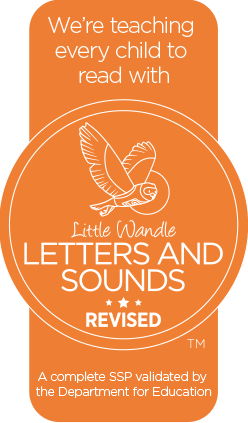
Early Reading Through Phonics
 At Sacred Heart, it is our intention that all our pupils enjoy reading as we strive to develop in them a life-long passion for reading. In order to achieve this, we must ensure children are immersed in a culture that prioritises and promotes the value of early reading i.e that this attitude is embedded from the beginning. From the start of Nursery and into Key Stage 1 and beyond.
At Sacred Heart, it is our intention that all our pupils enjoy reading as we strive to develop in them a life-long passion for reading. In order to achieve this, we must ensure children are immersed in a culture that prioritises and promotes the value of early reading i.e that this attitude is embedded from the beginning. From the start of Nursery and into Key Stage 1 and beyond.
We also believe in the importance of a strong and evidence-based systematic and synthetics phonics system. As a school, we use the Little Wandle Letters and Sounds Revised scheme as the core of our Phonics teaching. This scheme is approved by the Department of Education and has proven to be a strong base for the teaching of phonics and the outcomes of its use within our school supports this.
We implement this approach through an array of visual, auditory and kinaesthetic methods to support our phonics teaching.
Little Wandle is supported by a variety of Harper Collins resources including: flashcards, wall friezes and grapheme charts as well as 120 fully decodable reading books to support their reading. The books are age and stage appropriate and they enable us to meet the individual needs of our pupils while catering for their interests.
We start teaching Phonics in Nursery and follow the Little Wandle Letters and Sounds Revised progression, which ensures children build on their growing knowledge of the alphabetic code, mastering phonics to read and spell as they move through school.
The teaching of Phonics is fast-paced, we encourage all children to actively participate in each lesson, and by encourage the children to take ownership of their learning we are continuously striving for excellence.
At Sacred Heart Primary School, we ensure that we provide all children with the fundamental skills that will enable them to be confident and fluent readers.
In line with the Little Wandle planning, we allocate the phases across Nursery to Year Two as follows:
Foundations for phonics in Nursery.
We provide a balance of child-led and adult-led experiences for all children that meet the curriculum expectations for 'Communication and Language' and 'Literacy'. These include:
- Sharing high-quality stories and poems
- Learning a range of nursery rhymes and action rhymes
- Activities that develop focused listening and attention, including oral blending
- Attention to high-quality language
We ensure Nursery are well prepared to begin learning grapheme-phoneme correspondences (GPCs) and blending in Reception.
Daily phonics lessons in Reception and Year One
We teach phonics for up to 30 minutes a day. In Reception, we build from 10-minute lessons, with additional daily oral blending games, to the full-length lesson as quickly as possible. Each Friday, we review the week's teaching to help children become fluent readers.
We follow the Little Wandle Letters and Sounds Revised expectations of progress:
- Children in Reception are taught to read and spell words using Phase 2 and 3 GPCs, and words with adjacent consonants (Phase 4) with fluency and accuracy.
- Children in Year One review Phase 3 and 4 and are taught to read and spell words using Phase 5 GPCs with fluency and accuracy.
Daily Phonics Lessons in Year 2
In the Autumn Term we teach phonics for up to 30 minutes a day with an emphasis on revising Phase 5 planning, this prepares the children who will need to re-take the Phonics Screening test.
Using our phonics knowledge as a solid foundation, the children move on to learning weekly spelling pattern through the ‘No-nonsense Spelling’ scheme. Research demonstrates that this scheme dovetails into the Little Wandle Phase 6 seamlessly and so we believe that this scheme is the best way to transition and adequately prepare children for Key Stage 2.
Teaching reading:
Reading practice sessions
We teach children to read through reading practice sessions three times a week. These:
- are taught by a fully trained adult to small groups of approximately six children
- use books matched to the children’s secure phonic knowledge (Big Cat Little Wandle: Letters and Sounds Revised)
- are monitored by the class teacher, who rotates and works with each group on a regular basis.
Each reading practice session has a clear focus, so that the demands of the session do not overload the children’s working memory. The reading practice sessions have been designed to focus on three key reading skills:
- Decoding
- Prosody: teaching children to read with understanding and expression
- Comprehension: teaching children to understand the text.
In Reception these sessions start in Week 4. Children who are not yet decoding have daily additional blending practice in small groups, so that they quickly learn to blend and can begin to read books.
Phase 2 sounds taught in Reception Autumn 1
Phase 2 sounds taught in Reception Autumn 2
Phase 3 sounds taught in Reception Spring 1
How we teach blending


